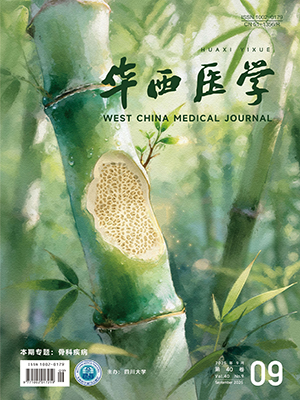【摘要】 目的 探讨脑干海绵状血管瘤患者临床表现及影响预后的相关因素。 方法 回顾分析2008年9月-2010年9月27例脑干海绵状血管瘤患者临床资料。 结果 20例(74.1%)患者CT显示出血及血肿。急性或突然神经功能废损22例,渐进性功能障碍15例,病情平稳4例。显微手术12例,放射治疗6例,保守观察9例。长期随访25例,2例再次出血,无新发病灶,无患者死亡。手术组患者年龄(P lt;0.05)、术前病情严重程度(P lt;0.05)与术后KPS评分相关。非手术组不良预后评分与患者高龄及再出血有关。 结论 展神经麻痹和面瘫患者功能恢复较差。年龄、术前病情严重程度及手术时机影响患者预后,术中全切病灶对复发和并发症发生起主要作用,如何处理合并发生的静脉畸形有待讨论。立体定向放射治疗明显降低再出血风险,但其适应证尚有争议。
【Abstract】 Objective To discuss the clinical manifestations and prognostic factors of brain stem cavernous hemangioma. Methods Based on the literature, the clinical data of 27 patients having brain stem cavernous hemangioma from September 2008 to September 2010 were reviewed and analyzed. Results Twenty patients (74.1%) presented with hemorrhage and hematoma in CT scan. Acute or sudden neurological deterioration occurred to 22 patients, progressive in 15 and stable in 4. Twelve patients underwent surgical removal of the lesion; 6 underwent radiosurgery; and 9 continued with conservative management. Twenty-five patients were followed up. Two patients had rehaemorrhagia. There were no de novo lesions or death. The risk factors indicative of a possible poor postoperative KPS score in the operative group included age (P lt;0.05) and the initial clinical condition (P lt;0.05). In the non-operative group, old age and rehaemorrhagia were obviously related to the poor outcome. Conclusions Patients with abducens and facial palsy have poor functional recovery. Age, the initial clinical condition and timing of operation are the major factors correlated to surgical outcome. The factor that affects recurrence and the occurrence of complications is complete resection during the operation. How to deal with the concomitant venous malformation should be further studied. The indications for stereotactic radiosurgery are still controversial, although it has confered a reduction in the risk of rehaemorrhagia.
Citation: SUN Jidong,LIU Yi,HE Min,SUN Hong,YOU Chao. Brain Stem Cavernous Hemangioma: Clinical Manifestations and Prognostic Analysis. West China Medical Journal, 2011, 26(3): 355-358. doi: Copy
Copyright © the editorial department of West China Medical Journal of West China Medical Publisher. All rights reserved




